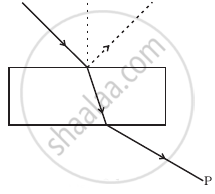Advertisements
Advertisements
Question
The transverse nature of light is shown in ______.
Options
interference
diffraction
scattering
polarisation
Solution
The transverse nature of light is shown in polarisation.
APPEARS IN
RELATED QUESTIONS
If the polarising angle for a given medium is 60°, then the refractive index of the medium is.................
Draw a neat labelled diagram showing the plane of vibration and plane of polarisation for polarised light.
Why does an unpolarised light incident on a polaroid get linearly polarised ?
What is the Brewster angle for air to glass transition? (Refractive index of glass = 1.5)
The refractive indices of water for red and violet colours are 1.325 and 1.334 respectively.
Find the difference between the velocities of rays for these two colours in water. (c = 3 × 108 m/s)
A ray of light is incident on a transparent medium at a polarizing angle. What is the angle between the reflected ray and the refracted ray?
Greenlight is an incident at the polarising angle on a certain transparent medium. The angle of refraction is 30°.
Find
(i) polarising angle, and
(ii) refractive index of the medium.
What is polarisation?
What is a polariser?
List the uses of polaroids.
What is the angle of polarisation and obtain the equation for an angle of polarisation?
What is double refraction?
Discuss about Nicol prism.
How is polarisation of light obtained by scattering of light?
What is normal focusing?
A plane mirror produces a magnification of
Which of the following phenomena is not common to sound and light waves?
Consider a light beam incident from air to a glass slab at Brewster’s angle as shown in figure. A polaroid is placed in the path of the emergent ray at point P and rotated about an axis passing through the centre and perpendicular to the plane of the polaroid.

An unpolarized light beam is incident on the polarizer of a polarization experiment and the intensity of light beam emerging from the analyzer is measured as 100 Lumens. Now, if the analyzer is rotated around the horizontal axis (direction of light) by 30° in clockwise direction, the intensity of emerging light will be ______ Lumens.
